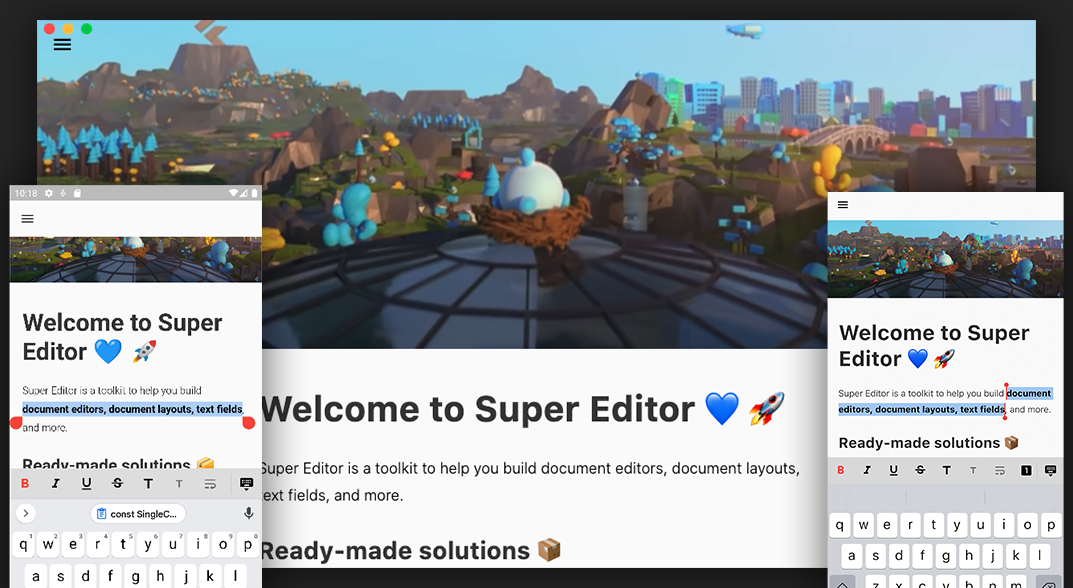
Open source, configurable, extensible text editor and document renderer for Flutter.
Super Editor works with any backend. Plug yours in and go!
super_editor was initiated by Superlist and is being implemented and maintained by the Flutter Bounty Hunters, Superlist, and the contributors.
Super Editor aims to support all platforms. For now, Super Editor supports the following:
Supported
Super Editor is actively developed against these platforms.
- Mac OS
- Web
- Android
- iOS
Unverified
These platforms probably work, but our verification on these platforms is spotty.
- Windows
- Linux
Super Editor comes with an example implementation to showcase the core functionality. It also exposes example UI elements on how to interact with the Editor. The example app should build and run on any platform. You can run the example editor from the example directory:
cd example
flutter run -d macosThe example implementation is only a proof of concept. Expect separate packages to implement various UIs on top of the editor.
Display a default text editor with the SuperEditor widget:
class _MyAppState extends State<MyApp> {
void build(context) {
// Display a visual, editable document.
//
// SuperEditor includes default magnifiers and popover toolbars for
// iOS and Android, but does not include any popovers on desktop.
// You can add your own, if desired.
//
// The standard editor displays and styles headers, paragraphs,
// ordered and unordered lists, images, and horizontal rules.
// Paragraphs know how to display bold, italics, and strikethrough.
// Key combinations are provided for bold (cmd+b) and italics (cmd+i).
return SuperEditor.standard(
editor: _myDocumentEditor,
);
}
}A SuperEditor widget requires an Editor, which is a pure-Dart class that's responsible for
applying changes to a Document. An Editor, in turn, requires a reference to the Document that
it will alter. Specifically, a Editor requires a MutableDocument.
// A MutableDocument is an in-memory Document. Create the starting
// content that you want your editor to display.
//
// Your MutableDocument does not need to contain any content/nodes.
// In that case, your editor will initially display nothing.
final myDoc = MutableDocument(
nodes: [
ParagraphNode(
id: DocumentEditor.createNodeId(),
text: AttributedText(text: 'This is a header'),
metadata: {
'blockType': header1Attribution,
},
),
ParagraphNode(
id: DocumentEditor.createNodeId(),
text: AttributedText(text:'This is the first paragraph'),
),
],
);
// A DocumentComposer holds the user's selection. Your editor will likely want
// to observe, and possibly change the user's selection. Therefore, you should
// hold onto your own DocumentComposer and pass it to your Editor.
final myComposer = MutableDocumentComposer();
// With a MutableDocument, create an Editor, which knows how to apply changes
// to the MutableDocument.
final editor = createDefaultDocumentEditor(document: myDoc, composer: myComposer);
// Next: pass the editor to your SuperEditor widget.The SuperEditor widget can be customized.
class _MyAppState extends State<MyApp> {
void build(context) {
return SuperEditor(
editor: _myDocumentEditor,
selectionStyle: /** INSERT CUSTOMIZATION **/ null,
stylesheet: defaultStylesheet.copyWith(
addRulesAfter: [
// Add any custom document styles, for example, you might
// apply styles to a custom Task node type.
StyleRule(
const BlockSelector("task"),
(document, node) {
if (node is! TaskNode) {
return {};
}
return {
Styles.padding: const CascadingPadding.only(top: 24),
};
},
)
],
),
componentBuilders: [
...defaultComponentBuilders,
// Add any of your own custom builders for document
// components, e.g., paragraphs, images, list items.
],
);
}
}If your app requires deeper customization than SuperEditor provides, you can construct your own
version of the SuperEditor widget by using lower level tools within the super_editor package.
See the wiki for more information about how to customize an editor experience.
